Python - Python Control Structures | 12th Computer Science : Chapter 6 : Core Python : Control Structures
Chapter: 12th Computer Science : Chapter 6 : Core Python : Control Structures
Python Control Structures
Control Structures
A program statement that causes a jump of
control from one part of the program to another is called control structure or control
statement. As you have already learnt in C++, these control statements are
compound statements used to alter the control flow of the process or program
depending on the state of the process.
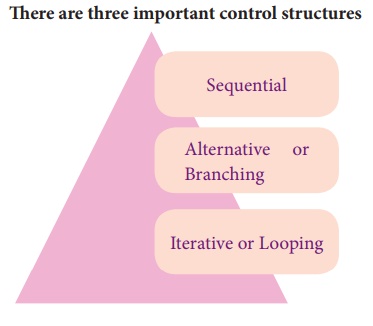
1. Sequential Statement
A sequential
statement is composed of a sequence of statements which are executed one
after another. A code to print your name, address and phone number is an
example of sequential statement.
Example 6.1
#Program to print your name and address - example for sequential
statement
print ("Hello! This is
Shyam")
print ("43, Second Lane,
North Car Street, TN")
Output
Hello! This is Shyam
43, Second Lane, North Car
Street, TN
2. Alternative or Branching Statement
In our day-to-day life we need to take various
decisions and choose an alternate path to achieve our goal. May be we would
have taken an alternate route to reach our destination when we find the usual
road by which we travel is blocked. This type of decision making is what we are
to learn through alternative or branching statement. Checking whether the given
number is positive or negative, even or odd can all be done using alternative
or branching statement.
Python provides the following types of alternative or
branching statements:
Simple if statement
if..else statement
if..elif statement
(i) Simple if statement
Simple if is the simplest of all decision making statements. Condition
should be in the
Syntax:
if <condition>:
statements-block1form of relational or logical
expression.
In the above syntax if the condition is true
statements - block 1 will be executed.
Example
#Program to check the age and
print whether eligible for voting
x=int (input("Enter your age
:"))
if x>=18:
print ("You are eligible for
voting")
Output 1:
Enter your age :34
You are eligible for voting
Output 2:
Enter your age :16
>>>
As you can see in the second execution no
output will be printed, only the Python prompt will be displayed because the
program does not check the alternative process when the condition is failed.
(ii) if..else statement
The if
.. else statement provides control to check the true block as well as the
false block. Following is the syntax of ‘if..else’
statement.
Syntax:
if <condition>:
statements-block 1
else:
statements-block 2
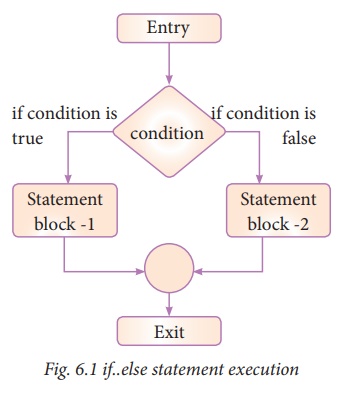
if..else statement thus provides two possibilities and the condition
determines which BLOCK is to be
executed.
Example 6.3: #Program to check if the accepted number
odd or even
a = int(input("Enter any
number :"))
if a%2==0:
print (a, " is an even
number")
else:
print (a, " is an odd number")
Output 1:
Enter any number :56
56 is an even number
Output 2:
Enter any number :67
67 is an odd number
An alternate method to rewrite the above
program is also available in Python. The complete if..else can also written as:
Syntax:
variable = variable1 if condition else variable 2
Example 6.4: #Program to check if the accepted number
is odd or even (using alternate method of if...else)
a = int (input("Enter any
number :"))
x="even" if a%2==0 else
"odd"
print (a, " is ",x)
Output 1:
Enter any number :3
3 is odd
Output 2:
Enter any number :22
22 is even
(iii) Nested if..elif...else statement:
When we need to construct a chain of if statement(s) then ‘elif’ clause can be used instead of ‘else’.
Syntax:
if <condition-1>:
statements-block 1
elif <condition-2>:
statements-block 2
else:
statements-block n
In the syntax of if..elif..else mentioned above, condition-1 is tested if it is true
then statements-block1 is executed, otherwise the control checks condition-2,
if it is true statements-block2 is executed and even if it fails
statements-block n mentioned in else
part is executed.
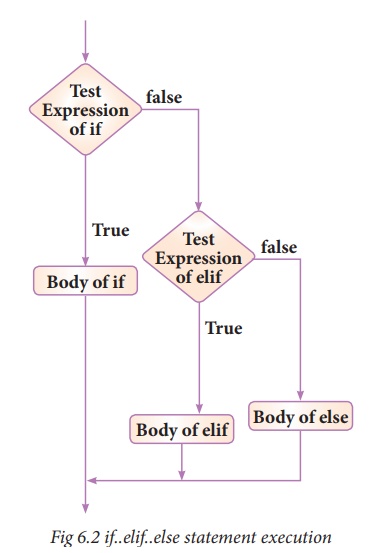
‘elif’ clause combines
if..else-if..else statements to one
if..elif…else. ‘elif’ can be considered
to be abbreviation of ‘else if’. In
an ‘if’ statement there is no limit
of ‘elif’ clause that can be used,
but an ‘else’ clause if used should
be placed at the end.
if..elif..else statement is similar to nested
if statement which you have learnt in C++.
Example 6.5: #Program to illustrate the use of nested
if statement
Average Grade
>=80 and above A
>=70 and <80 B
>=60 and <70 C
>=50 and <60 D
Otherwise E
m1=int (input(“Enter mark in
first subject : ”))
m2=int (input(“Enter mark in
second subject : ”))
avg= (m1+m2)/2
if avg>=80:
print (“Grade : A”)
elif avg>=70 and avg<80:
print (“Grade : B”)
elif avg>=60 and avg<70:
print (“Grade : C”)
elif avg>=50 and avg<60:
print (“Grade : D”)
else:
print (“Grade : E”)
Output 1:
Enter mark in first subject : 34
Enter mark in second subject : 78
Grade : D
Output 2 :
Enter mark in first subject : 67
Note
The two blocks of code in our example of
if-statement are both indented four
spaces, which is a typical amount of indentation
for Python. In most other
programming languages, indentation
is used only to help make the code look pretty. But in Python, it is required to indicate to which block of code the
statement belongs to.
Example 6.5a: #Program to illustrate the use of ‘in’
and ‘not in’ in if statement
ch=input (“Enter a character :”)
# to check if the letter is vowel
if ch in (‘a’, ‘A’, ‘e’, ‘E’,
‘i’, ‘I’, ‘o’, ‘O’, ‘u’, ‘U’):
print (ch,’ is a vowel’)
#to check if the letter typed is
not ‘a’ or ‘b’ or ‘c’ if ch not in (‘a’, ’b’, ’c’):
print (ch,’ the letter is not
a/b/c’)
Output 1:
Enter a character :e
e is a vowel
Output 2:
Enter a character :x
x the letter is not a/b/c
3. Iteration or Looping constructs
Iteration or loop are used in situation when
the user need to execute a block of code several of times or till the condition
is satisfied. A loop statement
allows to execute a statement or group of statements multiple times.
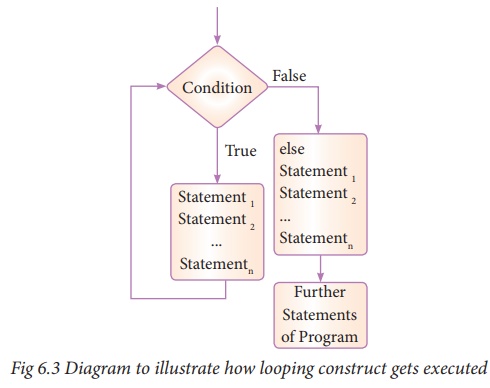
Python provides two types of looping constructs:
(i) while loop
(ii) for loop
(i) while loop
The syntax of while loop in Python has the following syntax:
Syntax:
while <condition>:
statements block 1
[else:
statements block2]
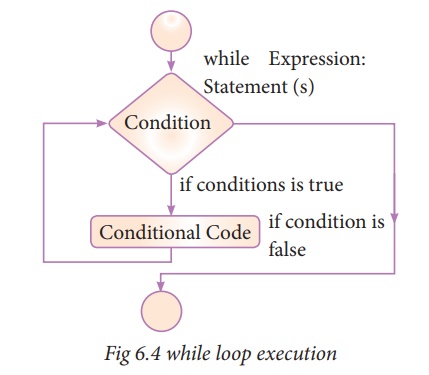
In the while
loop, the condition is any valid Boolean expression returning True or False.
The else part of while is optional
part of while. The statements block1 is kept executed till
the condition is True. If the else
part is written, it is executed when the condition is tested False. Recall while loop belongs to entry check loop
type, that is it is not executed even once if the condition is tested False in
the beginning.
Example 6.6: program to illustrate the use of while
loop - to print all numbers from 10 to 15
i=10 # intializing part of the control variable
while (i<=15): # test condition
print (i,end='\t') # statements - block 1
i=i+1 # Updation of the control variable
Output:
10 11 12 13 14 15
Note
That the control variable is i, which is initialized to 10, the
condition is tested i<=15, if
true value of i gets printed, then
the control variable i gets updated as
i=i+1 (this can also be written
as i +=1 using shorthand assignment operator). When i becomes 16, the
condition is tested False and this will terminate the loop.
Note
print can have end, sep as parameters. end parameter can be used when we need to give any escape sequences like ‘\t’ for tab, ‘\n’ for new line and so
on. sep as parameter can be used to
specify any special characters like, (comma) ; (semicolon) as separator between
values (Recall the concept which you have learnt in previous chapter about the
formatting options in print()).
Following is an example for using else part within while loop.
Example 6.7: program to illustrate the use of while
loop - with else part
i=10 # intializing part of the control variable
while (i<=15): # test condition
print (i,end='\t') # statements - block 1
i=i+1 # Updation of the control variable
else:
print ("\nValue of i when
the loop exit ",i)
Output: 1
10 11 12 13 14 15
Value of i when the loop exit 16
(ii) for loop
for loop is
the most comfortable loop. It is also an entry check loop. The condition is checked in the beginning and the body
of the loop(statements-block 1) is executed if it is only True otherwise the
loop is not executed.
Syntax:
for counter_variable in sequence:
statements-block 1
[else:
# optional block
statements-block 2]
The counter_variable
mentioned in the syntax is similar to the control variable that we used in the for loop of C++ and the sequence refers to the initial, final
and increment value. Usually in Python, for
loop uses the range() function in the
sequence to specify the initial, final and increment values. range() generates a list of values
starting from start till stop-1.
The syntax of range() is as follows:
range (start,stop,[step])
Where,
start – refers to the initial value
stop – refers to the final value
step – refers to increment value, this is
optional part.
Example 6.8:Examples for range()
range (1,30,1) will start the range of values from 1 and end at 29
range (2,30,2) will start the range of values from 2 and end at 28
range (30,3,-3) - will start the range of values from 30 and end at 6
range (20) will consider this value 20 as the end
value(or upper limit) and starts the range count from 0 to 19 (remember always
range() will work till stop -1 value only)
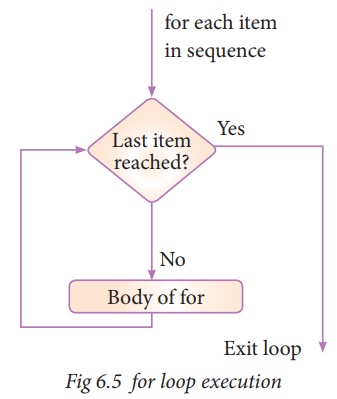
Example 6.9: #program to illustrate the use of for
loop - to print single digit even number
for i in range (2,10,2):
print (i, end=' ')
Output:
2 4 6 8
Following is an illustration using else part in for
loop
Example 6.10: #program to illustrate the use of for
loop - to print single digit even number with else part
for i in range(2,10,2):
print (i,end=' ')
else:
print ("\nEnd of the
loop")
Output:
2 4 6 8
End of the loop
Note
In Python, indentation is important in loop and
other control statements. Indentation only creates blocks and sub-blocks like
how we create blocks within a set of { } in languages like C, C++ etc.
Here is another program which illustrates the
use of range() to find the sum of numbers 1 to 100
Example 6.11: # program to calculate the sum of
numbers 1 to 100
n = 100
sum = 0
for counter in range(1,n+1):
sum = sum + counter
print("Sum of 1 until %d:
%d" % (n,sum))
Output:
Sum of 1 until 100: 5050
In the above code, n is initialized to 100, sum
is initialized to 0, the for loop
starts executing from 1, for every iteration the value of sum is added with the
value of counter variable and stored in sum. Note that the for loop will
iterate from 1 till the upper limit -1 (ie. Value of n is set as 100, so this
loop will iterate for values from 1 to 99 only, that is the reason why we have
set the upper limit as n+1)
Note
range () can also take values from string,
list, dictionary etc. which will be dealt in the later chapters.
Following is an example to illustrate the use of
string in range()
Example 6.12: program to illustrate the use of string
in range() of for loop
for word in 'Computer':
print (word,end=' ')
else:
print ("\nEnd of the
loop")
Output
C o m p u t e r
End of the loop
(iii) Nested loop structure
A loop placed within another loop is called as
nested loop structure. One can place a while
within another while; for within
another for; for within while and while within for to construct such nested loops.
Following is an example to illustrate the use
of for loop to print the following pattern 1
1 2
1 2 3
1 2 3 4
1 2 3 4 5
Example 6.13: program to illustrate the use nested
loop -for within while loop
i=1
while (i<=6):
for j in range (1,i):
print (j,end='\t')
print (end='\n')
i +=1
4. Jump Statements in Python
The jump statement in Python, is used to
unconditionally transfer the control from one part of the program to another.
There are three keywords to achieve jump statements in Python : break, continue, pass. The following
flowchart illustrates the use of break and continue.
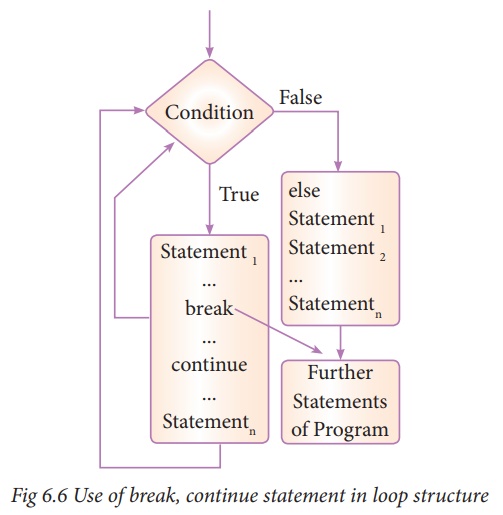
(i) break statement
The break
statement terminates the loop containing it. Control of the program flows to
the statement immediately after the body of the loop.
A while
or for loop will iterate till the
condition is tested false, but one can even transfer the control out of the
loop (terminate) with help of break
statement. When the break statement is executed, the control flow of the
program comes out of the loop and starts executing the segment of code after
the loop structure.
If break statement is inside a nested loop (loop
inside another loop), break will terminate the innermost loop.
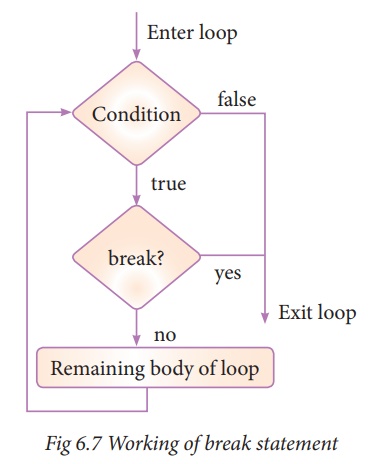
The working of break statement in for loop and while loop is shown below.
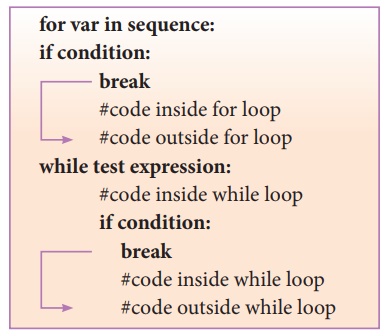
Program to illustrate the use of break statement
inside for loop
for word in “Jump Statement”:
if word = = “e”:
break
print (word, end= ' ')
Output:
Jump Stat
The above program will repeat the iteration
with the given “Jump Statement” as string. Each letter of the given string
sequence is tested till the letter ‘e’ is encountered, when it is encountered
the control is transferred outside the loop block or it terminates. As shown in
the output, it is displayed till the letter ‘e’ is checked after which the loop
gets terminated.
One has to note an important point here is that
‘if a loop is left by break, the else
part is not executed’. To
explain this lets us enhance the previous program with an ‘else’ part and see what output will be:
Program to illustrate the use of break statement
inside for loop
for word in “Jump Statement”:
if word = = “e”:
break
print (word, end=”)
else:
print (“End of the loop”)
print (“\n End of the program”)
Output:
Jump Stat
End of the program
Note that the break statement has even skipped the ‘else’ part of the loop and
has transferred the control to the next line following the loop block.
(ii) continue statement
Continue statement unlike the break statement
is used to skip the remaining part of a loop and start with next iteration.
Syntax
continue
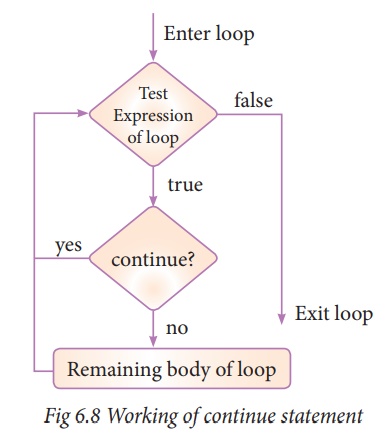
The working of continue statement in for and while loop is shown below.
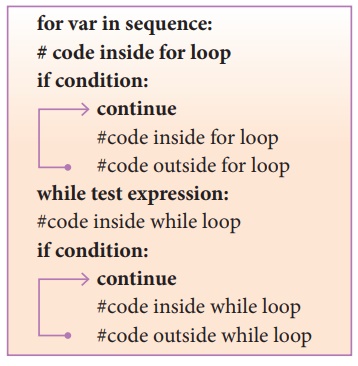
Program to illustrate the use of continue statement
inside for loop
for word in “Jump Statement”:
if word = = “e”:
continue
print (word, end=”)
print (“\n End of the program”)
Output:
Jump Statement
End of the program
The above program is same as the program we had
written for ‘break’ statement except that we have replaced it with ‘continue’.
As you can see in the output except the letter ‘e’ all the other letters get
printed.
(iii) pass statement
pass statement in Python programming is a null statement. pass statement
when executed by the interpreter it
is completely ignored. Nothing happens when pass is executed, it results in no
operation.
pass statement can be used in ‘if’ clause as well as within loop
construct, when you do not want any statements or commands within that block to
be executed.
Syntax:
Pass
Program to illustrate the use of pass statement
a=int (input(“Enter any number
:”))
if (a==0):
pass
else:
print (“non zero value is
accepted”)
Output:
Enter any number :3
non zero value is accepted
When the above code is executed if the input
value is 0 (zero) then no action will be performed, for all the other input
values the output will be as follows:
Note
pass statement is generally used as a placeholder. When we have a loop
or function that is to be
implemented in the future and not now, we cannot develop such functions or
loops with empty body segment because the interpreter would raise an error. So,
to avoid this we can use pass statement to construct a body that does nothing.
Example 6.18: Program to illustrate the use of pass
statement in for loop
for val in “Computer”:
pass
print (“End of the loop, loop
structure will be built in future”)
Output:
End of the loop, loop structure
will be built in future.
Related Topics